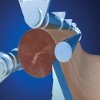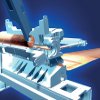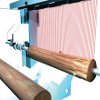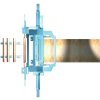A smart response
22 February 2004Founded in 1908 in Finland, Raute has always specialised in the peeling of logs to produce veneer, originally for the plywood industry. Over the years, that business has become more challenging as peeler log resources have become both more scarce and more expensive.
Having a Finnish background has, no doubt, helped Raute as the company has had to grapple with the problems of peeling one of the most difficult species – birch. The often small and irregularly-shaped logs, coupled with their small diameter and therefore whippy nature, has required the development of some very specific technologies.
The company has also supplied all the production lines for producing spruce veneer in Finland – an industry which has grown dramatically in more recent times.
But Raute is not just a Finnish company today. It has subsidiaries in Canada, the US, Germany, Singapore, Indonesia, China, Russia and Chile, so is familiar with a wide variety of raw material, both hardwood and softwood.
In other parts of the world than Finland, Raute has adapted its knowledge of peeling technology to such species as fir and pine in North America, tropical hardwood species in Asia and radiata pine in Australasia.
The company is also no longer just concerned with the production of plywood. The growth of laminated veneer lumber (LVL) as a construction product has also presented opportunities for it to expand its customer base. In fact it supplied the first eight-foot wide line to Finnforest’s Punkharju mill in 2001 and this is also capable of laying up some veneers with the grain at right angles to the main axis to produce a large size, plywood-like, panel with various applications.
The company has always had to concentrate on maximising the recovery of veneer from each log and its latest innovation in block optimisation is the SMART-SCAN XY+ system. This offers features such as 3-D block imaging and auto-calibration and Raute says it can be retrofitted to all existing lathes.
Raute claims the system is unique in that it utilises data from thousands of measuring points to create a true 3-D image of the block. This data is then used to optimise peeling in several ways.
Firstly, it can determine the largest cylinder within the block that will produce the greatest yield and it does this by using its 3-D imagery to undertake virtual peeling of each block, once every revolution of the spindles.
The company claims that recovery improvements of 0.4 to 3.0% have been achieved on a variety of wood species in this way and that the greater the variation from a true cylinder, the greater the benefits of SMART-SCAN XY+.
The second way in which the system operates is by optimising the position of the block relative to the point of contact with the knife. It does this by optimising the path of the knife during peeling, as well as the point at which the knife contacts the block at the start of the peeling cycle, in order to ensure that round-up waste is kept to a minimum. Surface defects on a block, such as knots, can cause spin-out and this is where the third optimisation feature comes in. The new Raute system is claimed to reduce this risk by accurately identifying such surface defects.
Smart Scan takes measurements in 1in (25mm) increments along the entire length of the block, identifying surface defects, such as those protruding knots. The operator only needs to monitor the process, as the carriage can be operated in fully-automatic mode.
As a result, the distance the carriage has to travel between peeling cycles can be reduced, says the company, and the knife carriage can be positioned as close as possible to the surface of the incoming block, taking into consideration protruding knots and butt flare. This means that cycle times can be reduced at the same time as reducing the risk of those spin-outs.
Unlike conventional X-Y systems, the line does not need to be stopped when calibrating SMART-SCAN, says Raute. This optional feature is claimed to reduce down time, save raw material and eliminate calibration errors.
The system has what Raute calls an advanced user interface which enables the block to be viewed as a picture image, grid, or geometric shape. In every case, a true 3-D image of the block is generated and can be stored in the computer’s memory. The system is also network-ready, making it accessible for remote diagnostics, reporting and servicing.
SMART-SCAN can be retrofitted to all existing lathe models and Raute arranges with a mill to have a representative travel to the site to determine the scope of the retro-fit required. Typically, it would involve the relevant controls, touchscreen, mounting hardware, multi-point laser sensors, temposonic probes and spindles.
This new scanning system follows fast on the heels of Raute’s Smart-Peel concept, formally launched at the Ligna exhibition in Hannover, Germany, last May.
Raute says the system was another product that was developed in response to the industry’s need to maximise value from its raw materials, regardless of wood species, block diameter or capacity requirements. It claims that flexibility is the key element here.
It incorporates the latest developments including the new optimal peeling geometry, digital knife carriage feed and what Raute claims is “the most rigid and accurate gap adjustment method yet designed”.
Of course the plywood industry is regarded as being at the ‘mature’ end of its product life cycle and has seen its market attacked first by particleboard, hardboard, then MDF, and in the construction and packaging sector by OSB.
However, there remain many applications where only plywood will do, whether for reasons of stability and thickness swell, strength-to-weight ratio, or pure aesthetics. It is said that the Egyptians invented plywood and it is showing little sign of disappearing from the specifiers’ portfolios.
But it has had to adapt to continually changing demands made on it and not least of these has been competitive pressure – price. Product costs have had to be reduced in the face of rising raw material costs, which means increases in efficiency have become a lot more than a luxury – they are a means of survival. Thus companies like Raute have had to find ways to maximise the returns from logs.
A new lease of life has been given to the technology used in plywood production by the advent of LVL. That product, made in a very similar way to plywood, has been relatively slow to gain market acceptance but that is changing. The quality demands that such a sophisticated engineering product as LVL makes on its manufacturers should help to ensure that veneer production technology remains at the ‘cutting edge’.



